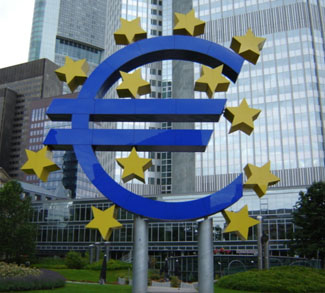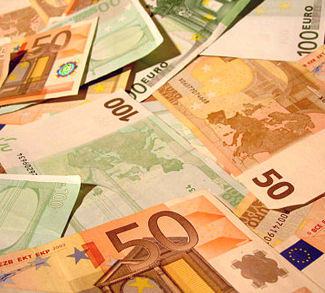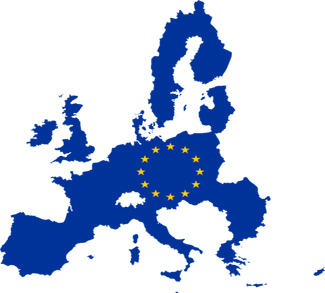It all started in October 2009 when George Papandreou’s new Greek government revealed a black hole in their accounts that was vastly underestimated by the previous administration. Several years of tumult followed, bringing the eurozone project to the brink of failure. But 2013 proved to be a lucky year for the 17-nation group. Relatively few economic surprises and heightened attention on events elsewhere brought a welcome calm to European financial markets.
This year the eurozone emerged from six quarters of economic contraction and the weaker nations enjoyed a strong rally in asset prices. Stock markets in the so-called PIIGS (Portugal, Ireland, Italy, Greece, Spain) have all rallied more than double figures year-to-date, while demand for each nation’s sovereign bonds has risen strongly, resulting in a significant decline in their borrowing costs.
Structurally, notable progress has been made on the enormous budget deficits that plagued the region. Optimism has been augmented by the imminent exit of Ireland and Spain from their respective EU/IMF bailout programs, with both countries set to make the transition to self-financing without the safety net of an emergency EU credit line.
The catalyst for positive sentiment came from the European Central Bank in July last year when President Mario Draghi said the phrase: “the ECB is ready to do whatever it takes to preserve the euro.” Those words were soon supported by a conditional bond-purchase program called OMT ( Outright Monetary Transactions) – a facility that has yet to be used.
The ECB’s actions signaled to financial markets that the central bank would indeed be a “lender of last resort,” effectively acting as guarantor for assets if the eurozone did verge on collapse. With that reassurance, markets have instead focused on the probable unwinding of the Federal Reserve’s bond-buying program and the slowdown in emerging market economies.
Yet even though there is less likelihood of a eurozone breakup, eventually markets will demand to see evidence of a return to eurozone prosperity. Incongruously, that objective is being hindered by the nation currently driving growth. Germany, the region’s largest economy, is expected to grow by 1.7% in 2014, which should lead to a 1.1% eurozone increase. However, Germany is vastly imbalanced – it has a huge current account surplus of 6.3% of GDP, meaning that it exports far more than it imports from the rest of the world. (A current account surplus of more than 6% is deemed excessive by the European Commission, but this limit is not enforced).
The strong influence of Germany on eurozone policy directives has resulted in the weaker nations enduring strict austerity and relying on export-led growth. The austerity has somewhat succeeded in reducing labor costs, thus boosting the competitiveness of eurozone products in global markets. Subsequently, most periphery nations are now running current account surpluses, but instead of stable economic models, these imbalances highlight worrying vulnerabilities. An over-reliance on exports may work for a strong economy such as Germany, but it is impossible for the whole eurozone to rely on such a model; the region is simply too big. There cannot be enough continuous demand from the rest of the world to provide prosperous stability for all individual eurozone economies.
An absence of strong domestic demand makes eurozone growth extremely fragile. Additionally, austerity without stimulus leads to weak consumer spending and risks facilitating a deflationary environment. The eurozone is nearing this scenario. The ECB predicts eurozone inflation of 1.1% in 2014, significantly below its 2% target. The weak number is a symptom of high unemployment and stagnant household income growth, highlighting the fragility of the region’s recovery.
Deflation is harmful to an economy as expectations of falling prices make consumers less inclined to spend. Moreover, deflation is particularly damaging for the periphery economies since it is difficult to further enhance competitiveness by cutting depressed wages, while the value of debt burdens cannot organically erode.
The ECB reacted to deflation concerns in November by cutting its benchmark interest rate (at which banks have to pay when they borrow money from the ECB) from 0.5% to 0.25%. This cut has come too late. The move was opposed by the German, Austrian and Dutch central banks, illustrating the divide between the sturdy and struggling eurozone economies. Germany’s resistance to an easier monetary policy comes from a fear of hurting their exporters’ competitiveness and perhaps lingering ghosts from the nation’s struggle with hyperinflation in the 1920s.
Such was Germany’s influence over the ECB in 2011 that the benchmark rate was increased 0.5% over the year to 1.5%. Mario Draghi’s presidential appointment in late 2011 has resulted in a much-needed decline in rates, greater ECB commitment to eurozone stability and a decline in Bundesbank influence.
Now the ECB must do more than prevent a eurozone collapse. The region cannot export away its problems; real growth must be spurred from within. The delay in reducing its benchmark rate may now force the ECB into unconventional action. Among the options are quantitative easing (creating new money to lower bond yields and borrowing rates), negative deposit rates (effectively charging banks to keep excess cash at the ECB) and long-term refinancing operations with strict lending conditions (providing cheap funding to banks that agree to lend to companies).
Financial markets should maintain a favorable view of the eurozone into 2014 as exports help steady, if slow, growth. But the time will come when slow growth is not enough, forcing the ECB into a standoff with Germany over aggressive stimulative actions. It may have been avoided if smaller measures were made earlier.




